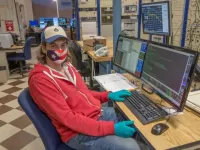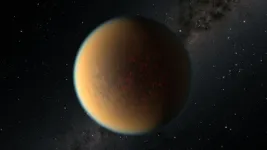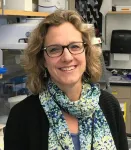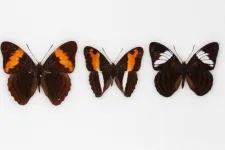Polarization: From better sunglasses to a better way of looking at asteroid surfaces
Unique technique may help planetary defense prepare for asteroids on a collision course with Earth
2021-03-11
(Press-News.org) Using the same principles that make polarized sunglasses possible, a team of researchers at the Arecibo Observatory in Puerto Rico have developed a technique that will help better defend against asteroids on a collision course with Earth.
A new study recently published in The Planetary Science Journal found a better way to interpret radar signals bounced off asteroids' surfaces. The data can better tell us if an asteroid is porous, fluffy or rocky, which matters because there are hundreds of near-Earth asteroids that could potentially hit the planet.
"Learning more about the physical properties of asteroids is crucial in Planetary Defense," says Dylan Hickson the lead author and a research scientist at the Arecibo Observatory in Puerto Rico. "A porous, fluffy asteroid does not pose as much of an impact threat as a dense, rocky asteroid does. With our research we can better prepare for potential asteroid impact events.
Depending on their size and composition some asteroids will burn up in the atmosphere, but others could cause catastrophic damage. Knowing how to deflect these potential threats will depend on what we know about their makeup.
Data collected from 1999-2015 with the Arecibo's main dish in Puerto Rico were used to complete the study. Arecibo is a U.S. National Science Foundation facility, which UCF manages for NSF under a cooperative agreement with Universidad Ana G. Méndez and Yang Enterprises Inc. The main dish collapsed in December, but work continues throughout the rest of the facility, and scientists continue to use previously collected data.
"When we send a radar signal with Arecibo, we know the exact polarization of the light, but when it bounces off of a surface, that can change how it's polarized," Hickson says. "If the asteroid surface was a smooth mirror, for example, it will reverse polarization 'perfectly' when the signal is reflected. With a rough and rocky surface, the light will interact with rock edges, cracks, and grains -- and reflect in a completely different polarization."
When the team analyzed Arecibo data, they broke down the polarization of the received signal into various components to decipher what surface features produced them. Is more of the surface fine-grained, smooth dust, sand-like grains or big rocks? Or is the surface full of small rocks and fine grains of dust?
Using polarimetric decomposition (polarization technique) isn't new, but it isn't 100% reliable yet. For example, scientists on NASA's OSIRIS REx mission were surprised by how rocky asteroid Bennu was when they arrived last year to begin a sample collection mission. Images taken from the spacecraft found the surface to be much more rocky than initial radar data indicated, and the team had to adjust its sample target site.
"Our results provide a methodology to extract more information about the surface properties from observations, giving us a better picture of what these mysterious surfaces look like," Hickson says. "Not only can this methodology be applied to archival data, but it can also be applied to future observations, potentially vastly increasing our understanding of the broader asteroid population."
INFORMATION:
Hickson is a postdoctoral research scientist in the Planetary Science Group at the Arecibo Observatory since 2019. He has a doctorate in Earth and space science from York University in Toronto, Canada and bachelor's degrees in Earth and environmental science and physical science from McMaster University in Hamilton, Canada.
The rest of the team on the paper includes: Anne K. Virkki and Phil Perillat from the Arecibo Observatory, Michael C. Nolan from the Lunar and Planetary Laboratory at the University of Arizona, and Sriram S. Bhiravarasu from Space Applications Centre in India.
[Attachments] See images for this press release:

ELSE PRESS RELEASES FROM THIS DATE:
2021-03-11
The planet GJ 1132 b appears to have begun life as a gaseous world with a thick blanket of atmosphere. Starting out at several times the radius of Earth, this so-called "sub-Neptune" quickly lost its primordial hydrogen and helium atmosphere, which was stripped away by the intense radiation from its hot, young star. In a short period of time, it was reduced to a bare core about the size of Earth.
To the surprise of astronomers, new observations from Hubble [1] have uncovered a secondary atmosphere that has replaced the planet's first atmosphere. It is rich in hydrogen, hydrogen cyanide, methane and ammonia, and also has a hydrocarbon haze. Astronomers theorise that hydrogen from the original atmosphere was absorbed into the planet's molten magma mantle and is now being slowly released ...
2021-03-11
Breast cancer is harmful enough on its own, but when cancer cells start to metastasize -- or spread into the body from their original location -- the disease becomes even more fatal and difficult to treat.
Thanks to new research published in Oncogene from the lab of University of Colorado Cancer Center associate director of basic research Heide Ford, PhD, in collaboration with Michael Lewis, PhD, from Baylor College of Medicine, doctors may soon have a better understanding of one mechanism by which metastasis happens, and of potential ways to slow it down.
"Metastasis is a huge problem nobody's tackled very well," says Ford, who ...
2021-03-11
The universe is filled with magnetic fields. Understanding how magnetic fields are generated and amplified in plasmas is essential to studying how large structures in the universe were formed and how energy is divided throughout the cosmos.
An international collaboration, co-led by researchers at the University of Rochester, the University of Oxford, and the University of Chicago, conducted experiments that captured for the first time in a laboratory setting the time history of the growth of magnetic fields by the turbulent dynamo, a physical mechanism thought to be responsible for generating ...
2021-03-11
Optical-resolution photoacoustic microscopy (OR-PAM), a new hybrid imaging technique, allows us to listen to the sound of light and see the color of biological tissue itself. It can be used for live, multicontrast functional imaging, but the limited wavelength choice of most commercial lasers and the limitations of the existing scanning methods have meant that OR-PAM can obtain only one or two different types of contrast in a single scan. These limitations have made multicontrast functional imaging time-consuming, and it's been difficult to capture the ...
2021-03-11
Ann Arbor, March 11, 2020 - Black and Hispanic people experience a higher risk for COVID-19 and severe illness, influenced by factors such as discrimination, housing, and healthcare access and utilization. Now, a END ...
2021-03-11
CHAMPAIGN, Ill. -- The chronic stress of living in neighborhoods with high rates of violence and poverty alters gene activity in immune cells, according to a new study of low-income single Black mothers on the South Side of Chicago.
The changes in stress-related gene expression reflect the body's "hunker down" response to long-term threat, a physiological strategy for lying low and considering new actions rather than launching an immediate "fight-or-flight" response. This has implications for health outcomes in communities of color and other marginalized populations, said researchers at the University of Illinois Urbana-Champaign and collaborators at the University of Kentucky and UCLA. The researchers published the study in the journal Psychoneuroendocrinology.
"The ...
2021-03-11
GAINESVILLE, Fla. --- The showy colors of some butterflies could advertise their speed and nimbleness, much like a coat of bright yellow paint on a sports car. A new study shows birds can learn to recognize these visual cues, avoiding not only butterflies they've failed to nab in the past but similar-looking species as well.
The research provides some of the strongest evidence to date for the idea of evasive mimicry, a strategy in which animals protect themselves from predators by matching the colors or patterns of agile relatives. First proposed more than 60 years ago, the hypothesis has been a challenge to test.
But in an experimental setting, ...
2021-03-11
SAN ANTONIO -- Surgically opening the windpipe, or trachea, within the first seven days of the start of mechanical ventilation decreases the time patients spend on ventilators, shortens their ICU stay and lowers their risk of ventilator-associated pneumonia, according to a systematic review published Thursday (March 11) in JAMA Otolaryngology-Head & Neck Surgery.
"We analyzed the existing medical literature to unravel a question that is very pertinent to adult critical care," said senior author Alvaro Moreira, MD, MSc, of The University of Texas Health Science Center at San Antonio (UT Health San ...
2021-03-11
The global battle against antibiotic resistance can only succeed if local contexts are taken into account. "A tailored approach is needed in each country," says Heiman Wertheim of Radboud university medical center. "There is no "one-size-fits-all' solution." This was the main finding of a study on antibiotic resistance in African and Asian countries funded by the British Wellcome Trust. Wertheim is the lead investigator of a large group of international researchers who recently published an article on this study in The Lancet Global Health.
Antibiotics are powerful treatments for bacterial infections. They are indispensable for controlling infections such as pneumonia, meningitis, or blood poisoning (sepsis) caused by bacteria. But they are ineffective for treating ...
2021-03-11
Sugar has been called "evil," "toxic," and "poison." But the body needs sugars, too. Sugar molecules help cells recognize and fight viruses and bacteria, shuttle proteins from cell to cell, and make sure those proteins function. Too much or too little can contribute to a range of maladies, including neurodegenerative diseases like Alzheimer's, inflammation, diabetes, and even cancer.
About 85 percent of proteins, including those associated with Alzheimer's and Parkinson's, are beyond the reach of current drugs. One critical and abundant sugar (O-GlcNAc, pronounced o-glick-nack) is found on over 5,000 proteins, often those considered "undruggable." But now, researchers at Harvard University ...
LAST 30 PRESS RELEASES:
[Press-News.org] Polarization: From better sunglasses to a better way of looking at asteroid surfaces
Unique technique may help planetary defense prepare for asteroids on a collision course with Earth





